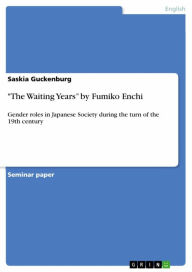'The Waiting Years' by Fumiko Enchi: Gender roles in Japanese Society during the turn of the 19th century
by Saskia Guckenburg
2020-05-08 04:49:02
'The Waiting Years' by Fumiko Enchi: Gender roles in Japanese Society during the turn of the 19th century
by Saskia Guckenburg
2020-05-08 04:49:02
Seminar paper from the year 2011 in the subject English Language and Literature Studies - Literature, grade: 1,7, University of Mannheim, course: The New Woman in American Short Fiction, language: English, abstract: Fumiko Enchi has worked on Onnazak...
Read more
Seminar paper from the year 2011 in the subject English Language and Literature Studies - Literature, grade: 1,7, University of Mannheim, course: The New Woman in American Short Fiction, language: English, abstract: Fumiko Enchi has worked on Onnazaka for eight years, which has been translated to English under the title of The Waiting Years. The novelist-critic Takami Jun describes it as 'a rare jewel among masterpieces of modern literature'. The novel reveals how the family system of Meiji Japan (1868-1912) leads to an exploitation of the women and treats various problems which the protagonist Tomo Shirakawa faces. The role of the concubines provides a profound double structure. The novel is a fictional transfor-mation of Enchi's grandmother Ine's painful life who endured a polygynous marriage with a man from a samurai family. The protagonist's suffering and pain expresses Enchi's own pro-test against the system and the maltreatment of women. First published in pieces in journals, it came out in a book form in 1957. During that time women were resisting the government to reintroduce the traditional Japanese family system. Enchi published several critical novels in the late 1960s criticizing the patriarchal social order. The novel won the Noma Literary Prize, one of Japan's most prestigious literary awards. Usually the prize is only given to one work, but in 1957 it was awarded jointly to this novel and to Uno Chiyo's Ohan, which glorifies women's submissiveness to her husband as a true feminine virtue. In this way, women opposing the 'ie' system and men supporting it should both be pleased. To understand the situation of Japanese women during the Meiji period it is necessary to ana-lyze men's behavior and to reveal the political and historical background. Therefore, the first section of the paper deals with men's roles. The second section deals with the depiction of women.
Less















.jpg)

.jpg)












